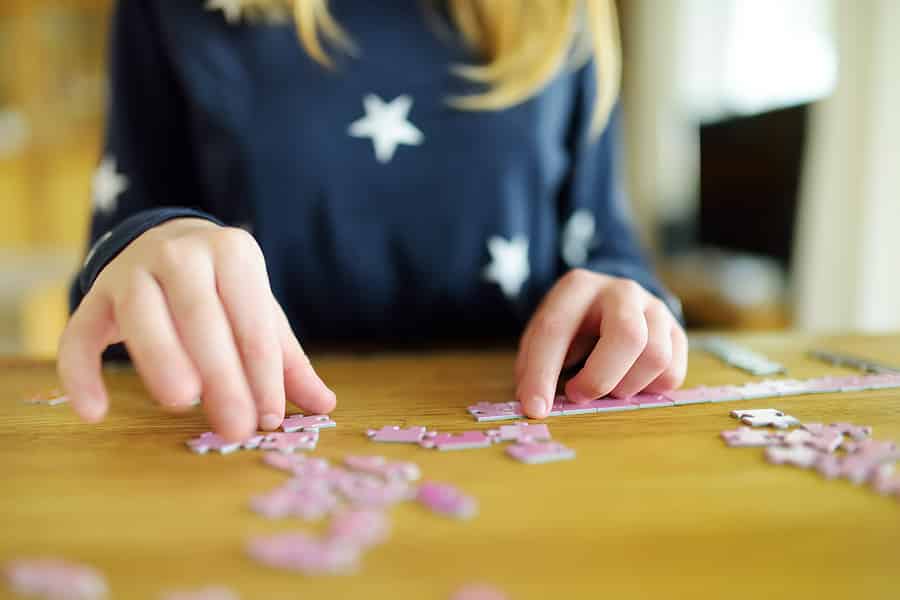Last Updated on May 26, 2021 by JigsawPuzzleGuru

Jigsaws are a fun, mentally stimulating activity, but can be extremely daunting in the beginning if you have a high number of pieces. It’s very common for those taking on a jigsaw puzzle to feel like they have no idea where to start or how to proceed. In today’s blog, we’re sharing with you several great tips for solving jigsaw puzzles
Hopefully, the strategies we mention below will make completing the jigsaw a more enjoyable experience for you and the whole family if you’re completing it together.
Table of Contents
Tip #1: Create a Large, Flat, and Empty Surface
The first key to successful jigsaw solving is creating the right kind of space. You need a large, even space on which to work, first of all. The ideal space will allow you to spread the jigsaw pieces about without getting them too close to an edge where they might fall or be easily brushed off by mistake.
The space should be a flat one. The important thing is that it can house your pieces safely. In addition, it should be a surface that you or other family members don’t typically need. Therefore, puzzles that are going to take more than a few hours or so should probably not be done on the family dining table.
One further consideration are drafts. You’ll also want to make sure that there is no strong breeze blowing across the space that could send some pieces flying away to the ground. A well-chosen space on which to complete the puzzle will help a lot in avoiding frustration.
Tip #2: Use a Mat or a Puzzle Table to Prevent Loss of Pieces
A good solution to the space issue can be purchasing a special mat or a puzzle table on which to do the jigsaw. These are good because their material is typically designed to prevent pieces from sliding away.
In particular, puzzle tables are perfect. They allow you to manage the puzzle pieces, store them away in drawers, and work the puzzle in an organized way. This is very useful on larger puzzles. The less you have to worry about a lost piece makes solving jigsaw puzzles easier.
A mat or table aims to minimize disorganization and discomfort. It is the discomfort of not being able to get the best view, or of having to constantly bend down to pick up dropping pieces that make jigsaw puzzle solving far less enjoyable.
Tip #3: Let There Be Light
Larger jigsaws with more pieces often feature quite intricate patterns and details in their images. Without the proper light, you may miss those details and find yourself increasingly frustrated. It is therefore a huge benefit to you to have your jigsaw area well illuminated.
The easiest thing to do is to set your jigsaw area in a room with multiple windows and lots of natural light. That solves the problem at least during the day. If you’re doing a jigsaw after school or after work, however, then you’ll likely need additional light. You can position the puzzle table beneath a room’s main light if possible, or you can purchase an adjustable standing lamp that you can point over your puzzle. As long as you can avoid casting shadows and you can see your pieces and images clearly, then the experience will be improved.
Tip #4: Sort and Group the Pieces
Here’s a good tip to help you organize the “chaos” of those first moments with your jigsaw puzzle pieces. When you (carefully) tip the pieces of the box onto your well-lit jigsaw area, it can look as though you’ve just unleashed merry hell upon yourself. One of the best ways to get started is by sorting through the pieces strategically.
For instance, you could find all the pieces that have a straight or perpendicular edge. These are going to form the border of the jigsaw, and so should be somewhat easier to assemble than the middle of the puzzle. You can sort other pieces by color according to the finished image on the box (see tip #5), or in some other way, you see fit.
Remember that depending on the exact image, you might not easily be able to group all the pieces. If the puzzle image has a very intricate color scheme or pattern, or a very “busy” depiction of something, then you might have to hold off on grouping beyond getting the border pieces.
Tip #5: Go Back to the Puzzle Image Regularly
Another great tip for solving your jigsaw effectively is to return regularly to the image on the box or included poster and take note of particular details. Let’s say you’re working on a jigsaw puzzle depicting a famous portrait and you’re currently working on the face. By inspecting the original image, you can spot certain details of the face that you can then look for within the pieces you currently have yet to fit.
By looking at the background colors and smaller details, you can narrow down which pieces you need for that particular “zone” of the puzzle and thus increase the speed with which you can find them. This makes the process much more enjoyable overall. Those who get frustrated when they are unable to find a piece could often fix that frustration simply by revisiting that image and getting a better idea of what they are searching for.

Tip #6: Take Frequent Breaks
Complex jigsaws can take time to solve. If you are working on it alone, it might take you several days or longer. It’s important that you take breaks at regular intervals so you can refresh yourself, but also provide yourself with some needed distractions. Sometimes, those intermittent distractions provide you with the mental “clean slate” that you need to come back to the jigsaw and then make a major breakthrough.
Have you ever pondered a problem in your life, set it aside for a short time to take a break, perhaps going out to take a walk in the meantime, and then have the solution pop into your mind just as soon as you’re not thinking about it? The same can happen with jigsaws. When you come back from your break, you’ll find those pieces you need were right there in front of you all along.
Tip #7: Bring in “Fresh Eyes”
Finally, if you’ve been working on a jigsaw for some time and you find yourself stuck in one area, then don’t be afraid to call in a pair of “fresh eyes,” perhaps a friend or family member, to take a look with you. Sometimes, the eyes of someone who has never seen the jigsaw will quickly turn up a solution compared to your own tired eyes. It’s a tried-and-tested method that works in many areas of life, and it absolutely should not detract from your own sense of achievement.
Conclusion: Follow These Tips for Solving Jigsaw Puzzles
A jigsaw puzzle should be something fun for the whole family to work on. It shouldn’t feel like a chore, and it should never get to a point of anger or frustration. The key to avoiding these pitfalls is to do everything you can to make your puzzle-solving time comfortable and fun.
By creating the right kind of space with good lighting, sorting the pieces smartly, referring back to the original image, taking regular breaks, and calling in the fresh-eye reinforcements when needed, you’re sure to make your jigsaw time much more positive and beneficial.
Stay tuned for more jigsaw puzzle tips!
